How to Create Food Delivery App: Features & Tech Details
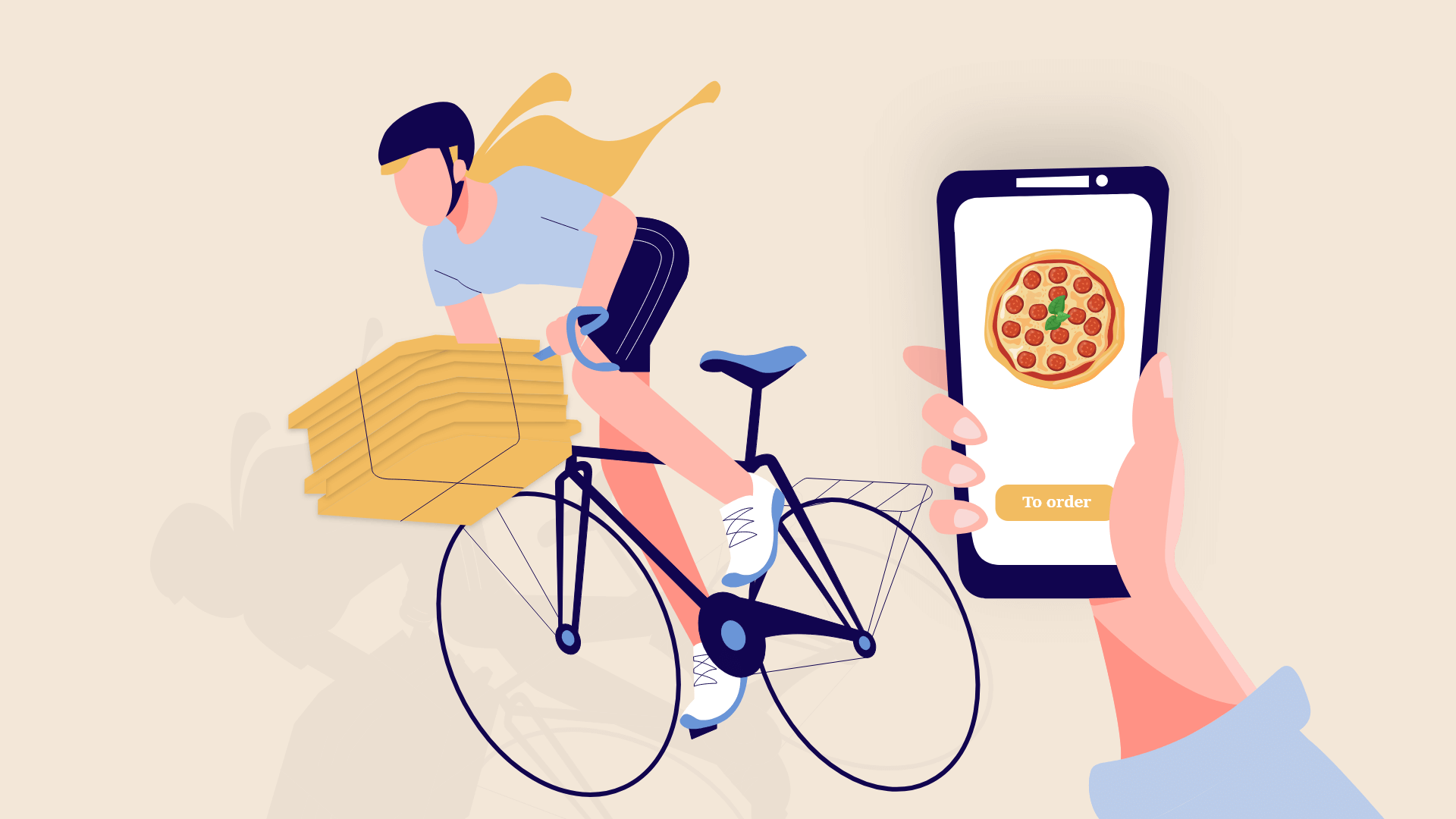
Have you ordered food delivery today? Or maybe you did it yesterday? There is a good chance you do it every day or at least three times a week. Back in the days of total lockdown, people found food delivery services a life necessity. Undoubtedly, this was a disruptive factor in the food delivery industry. Numerous businesses transformed and upgraded their business models by implementing delivery services and, primarily, delivery apps that were even more functional and customer-centric. We have chosen this industry and food delivery app development as a new business idea to invest in.
To help things work out, we have carried out extensive research touching on the following critical points for your future project. This guide will help you learn how to create a food delivery app from both business and technical perspectives:
- Why on-demand delivery services are a good idea to start in 2024
- Key food delivery business models to start with
- Must-have features of food delivery app
- Step-by-step guide to creating a food delivery app
- Technical aspects of food delivery app development
Let’s get to business.
Why Invest in Food Delivery App Development
The change in consumer behavior amid the pandemic and global lockdown gave the food delivery industry a considerable boost. Of course, food delivery services and apps existed and prospered long before the pandemic. Still, we do draw a thick red line in discussing industry behavior before and after the pandemic. Let’s take a look at some numbers and official data.

The global on-demand food delivery market will register over $910 billion by 2023. China leads with the number of users and revenue (US$1.22tn in 2024). The Us on-demand food delivery app was valued at US$0.79tn in 2024. By the end of this year, it will reach $30 million; one year later, the number will be updated to $33 billion. By 2025, the food delivery app sector will reach $42 billion.
Today, food delivery applications are generating huge revenue. Just take a look at some industry leaders in the U.S.
| Revenue | Number of Monthly Users | |
| DoorDash | $8.15 billion (September 30, 2023) | 32 million |
| GrubHub | 1.82 billion | 31 million |
| Uber Eats | 8.3 billion | 88 million |
| Postmates | $1 billion | 9.3 million |
| Instacart | 2.55 billion | 34 million |
All the statistics show that the industry of on-demand meal delivery will only grow in the future. That’s why many businesses think of investing in food delivery app development.
Food Delivery Business Models
Food delivery application can support a single restaurant or many restaurants, cafes, and fast food. The application will have different components and a project development lifecycle depending on which type you choose.
When you consider how to create a food delivery app, keep in mind that there are three types of food delivery business models. Those are the business models to consider.
- Aggregators with logistics
- Aggregators without logistics
- Hybrid food delivery solutions
Let’s find out how they differ.
Food Delivery Aggregator with Logistics
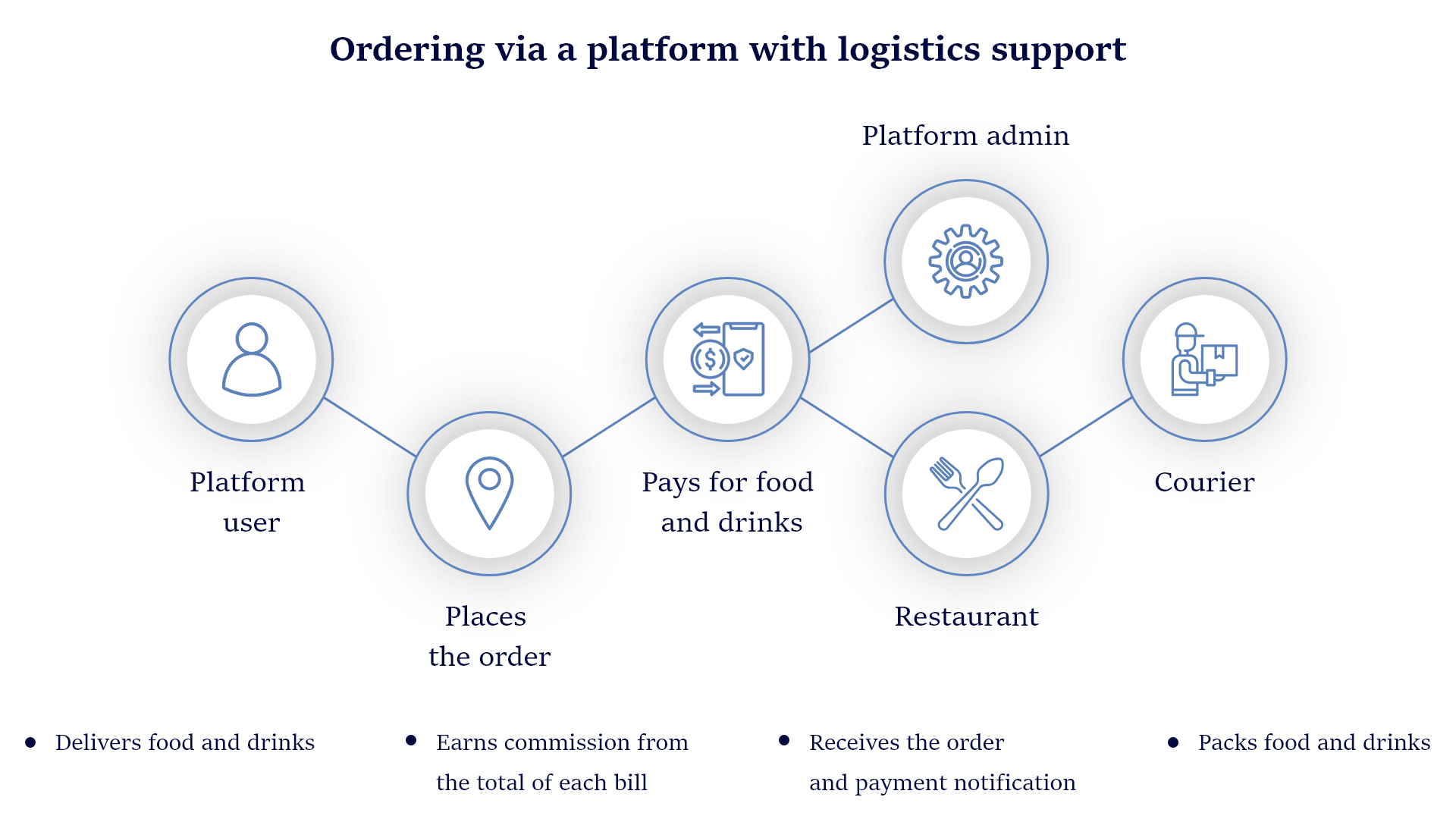
Mobile food ordering apps of an aggregator type act as an intermediate between customers and restaurants. They allow dining establishments to find customers and for users to order from their favorite restaurants. A food delivery aggregator can either provide delivery services or not.
After an order is placed, it is redirected to the restaurant that prepares and packs the order up in its turn. The driver provided by the aggregator picks it up and delivers it to the client. Such applications usually make money by taking commissions for an order or food delivery. The top popular example is DoorDash
Food Delivery Aggregator
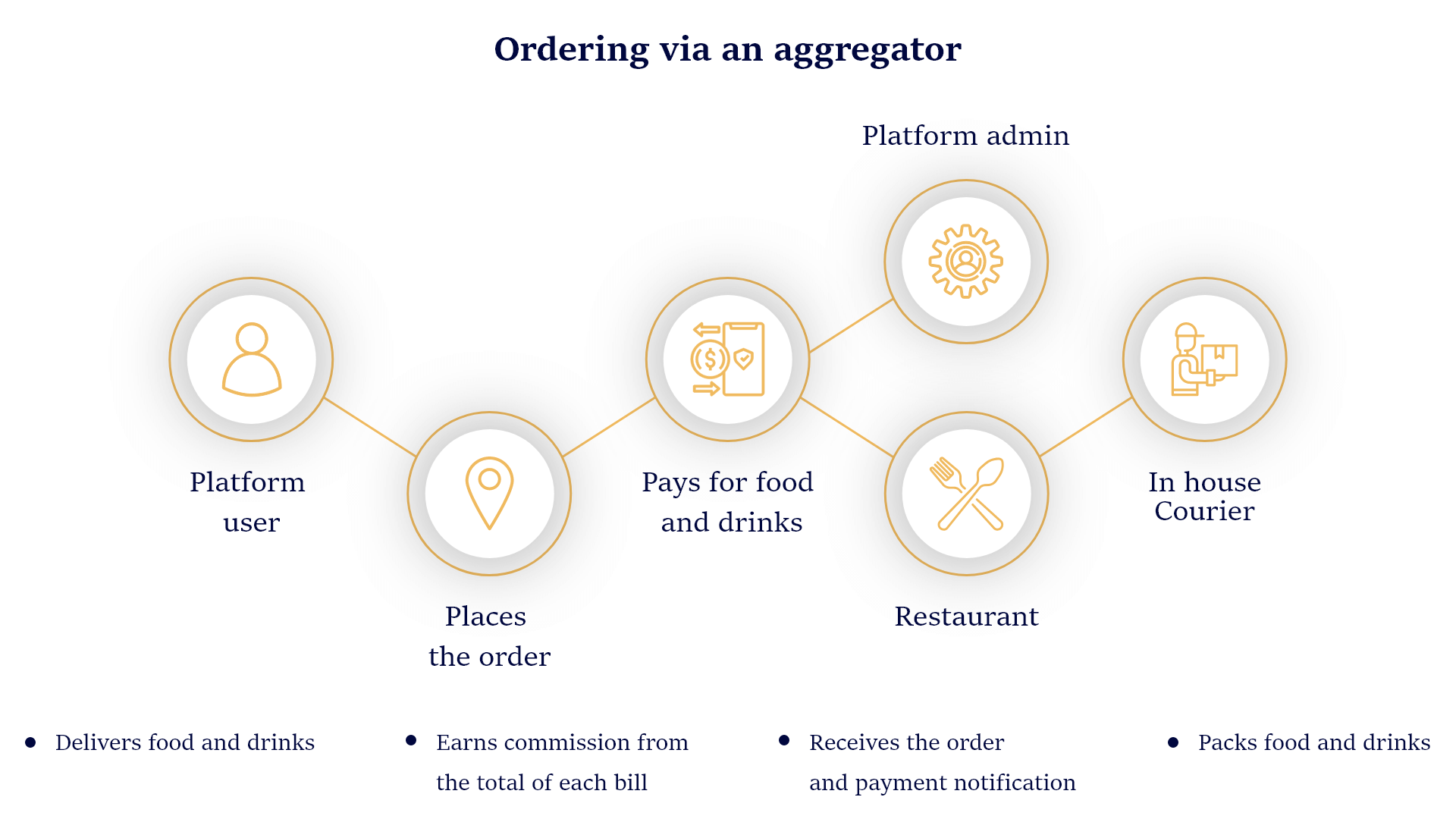
The aggregator app doesn’t provide delivery services. After a user places an order within an app and it’s redirected to the restaurant, the aggregator takes a commission and is over with that order. If you wonder how to create a food delivery app of this type, you won’t need to invest a lot of money upfront since you don’t need to create your own fleet and hire couriers.
Often startups work on this business model at the beginning of their journey, with GrubHub being a great example.
Hybrid Food Delivery Applications
Food delivery applications of the third type also provide the delivery option to restaurants and clients. The main difference between aggregators with hybrid platforms is that the second type works with a delivery company that provides couriers and delivers all orders.
Restaurants that want to create a branded application but don’t have many resources to organize their own fleet often choose this type of food delivery app development. You can partner up with Uber Eats or DoorDash to deliver the orders that you get within your application.
Key Features of Food Delivery App Development
You can’t know how to create a food delivery app without understanding which features go into development. The features differ since a meal delivery app might consist of different parts for end-users, restaurants, and couriers.
Let’s look at the main features of on-demand food delivery apps.
Food Delivery App Features for Customers

The food delivery app for customers have the following features:
- Sing up and log in – users should be able to create an account with your application and then sign in when needed.
- Profile/account page – after users sign up with your application, they need to have the ability to provide personal data (name, delivery address, and even add their payment details).
- Restaurant search – this feature can be implemented in different ways, and it should help users find restaurants. You might include different solutions, such as searching by location with GPS, cuisine, etc.
- Order placement – it is the main feature that allows consumers to choose food and make an order.
- Integrated online payment – after a user puts an order within your application, the next step is the payment for that order. You can integrate different payment solutions, the most popular being Apple Pay, Google Pay, PayPal, Stripe, and others, depending on the location where you will provide your application.
If you want to know how to create a food delivery app that customers will fall in love with, you might need to consider adding some nice-to-have features that will improve the user experience of your application.
- Notifications – the feature will help you keep customers informed of their order’s status and notify them about new offerings, special offers, etc.
- Order tracking – the feature helps track the order status in real life.
- Loyalty programs – this feature will help retain customers by offering special offers and discounts to the most loyal ones. You can build a robust loyalty program and integrate different rules.
- History of orders – it might be helpful for users to access the history of all orders ever made with your application.
Food Delivery App Features for Restaurants
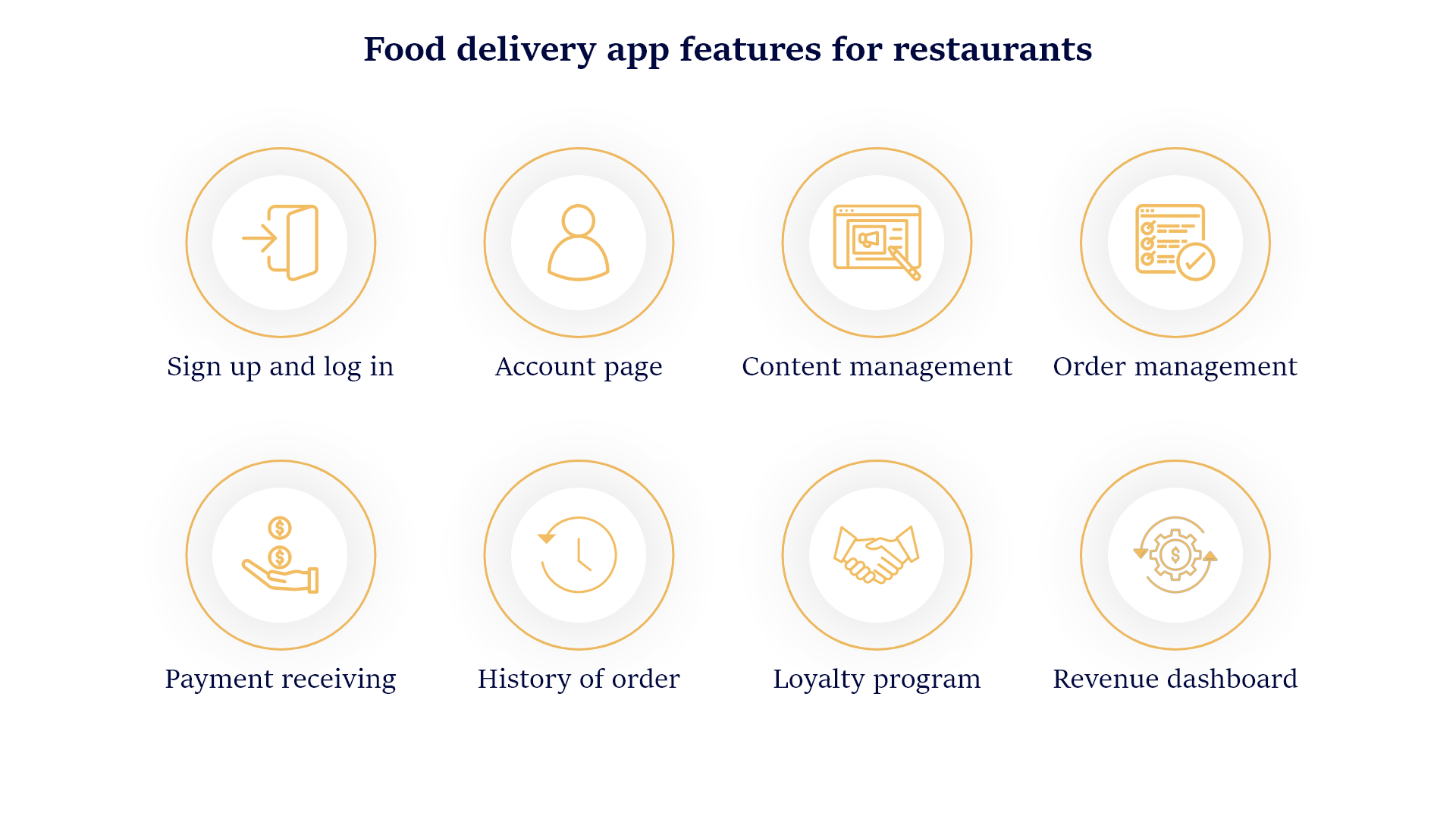
You will also need to think about features for the app designed for restaurants. When you are working on this part of the app, you will need to think about how to create a food delivery app from a business perspective and try to solve the issues that restaurants might have.
Food Delivery Application Features for Couriers
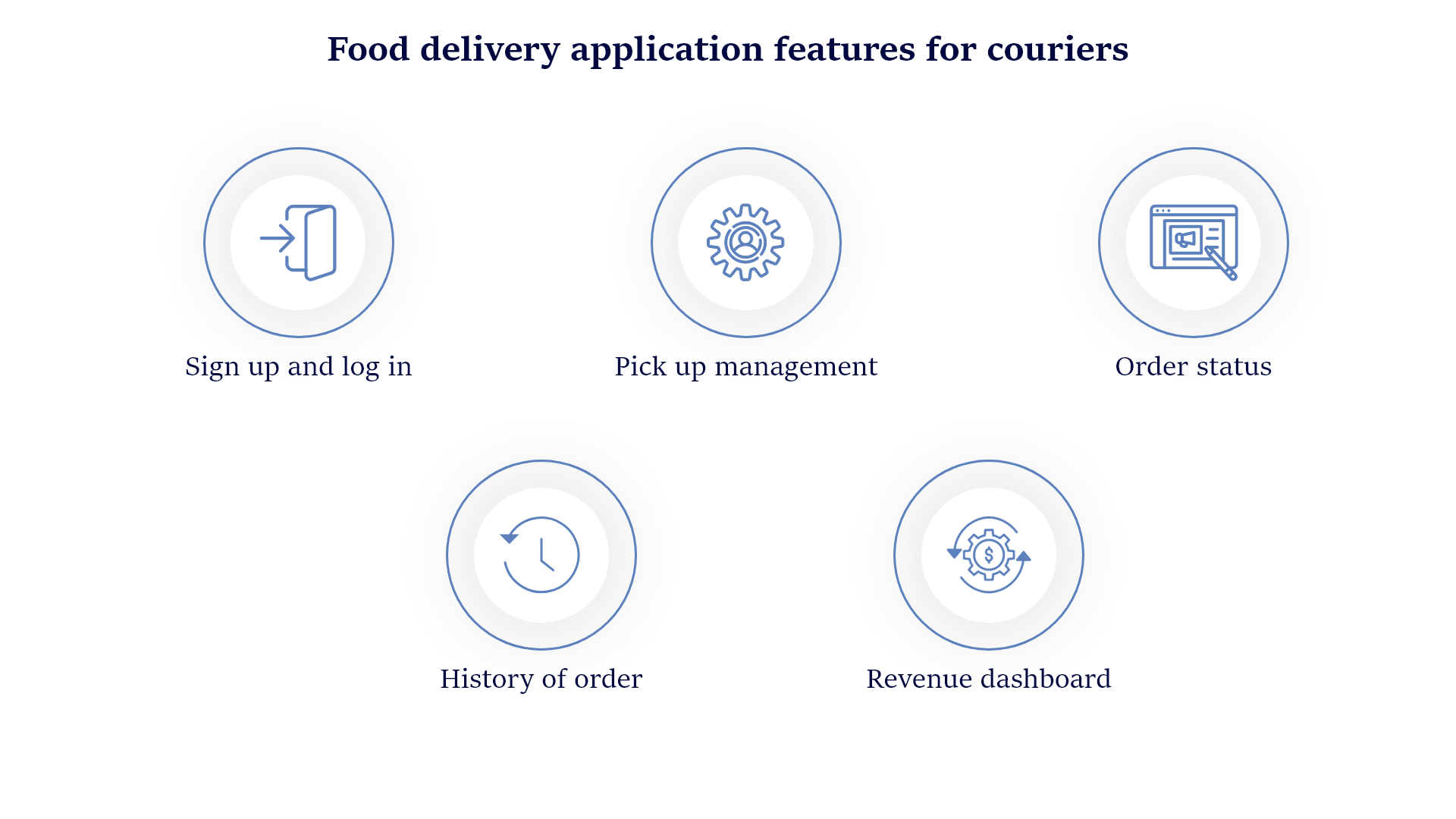
The app for couriers needs to provide them with all the required features for delivery. The list of features can include different functionality.
- Sign up and sign in – the feature to register an account. It’s possible to integrate the social login option with Google, Facebook, etc., to make the process faster and smoother.
- Order status – displays the list of available orders and delivery details.
- Pick-up management – the feature allows couriers to manage pick-ups, like tracking the locations, estimating delivery time based on the distance, traffic, etc.
Aside from basic features, there are some additional, nice-to-have ones:
- The revenue dashboard – demonstrates the earnings of the courier for each delivery and the total sum. This feature might give the ability to filter the revenue by days, months, etc.
- History of orders – access to the whole history of orders with different filtering options.
Get in touch with our team, and we will be happy to create a user-friendly food delivery application and monetize your project.
How to Create Food Delivery App Step by Step

Creating a food delivery app like Uber Eat might seem a good idea. However, you won’t be able to get far with a copycat of a popular solution. The main secret of creating a successful application is to have a value proposition with a competitive advantage that may solve the problems of target users.
Analyze Market
The first and most crucial stage of food delivery app development is market analysis. You can’t make any decisions without knowing your users and competitors and identifying the market challenges.
This stage also includes the efforts of development company research in case you don’t have an in-house team. The best practice for app development is outsourcing to an offshore company that will cover all the processes; market research, project estimation, design, development, testing, and ongoing support. You can use Clutch, GoodFirms, and the Manifest directories to search for a vendor.
Market research will help you define how you can succeed in the industry:
- Select the market where you want to launch the solution
- Identify your main competitors and analyze their strong and weak points
- Come up with ideas on how you can make your application better
- Find your target audience and learn what they are looking for
- Test your app idea to see how your target audience will react to it
Create a Value Proposition
Market research, and competitor analysis is aimed at revealing the white spots where you can fill with your unique solution. It means you need to create a similar app with the functionality already approved by users and simultaneously offer new features that will make your app stand out from the rest of the available solutions.
Aside from being unique, your application should address your target audience’s needs, be user-friendly, and help you with your business targets.
When you have everything sorted out, you can create a business model canvas to highlight the main value of your solution.
The image below is an example of such a business model canvas.
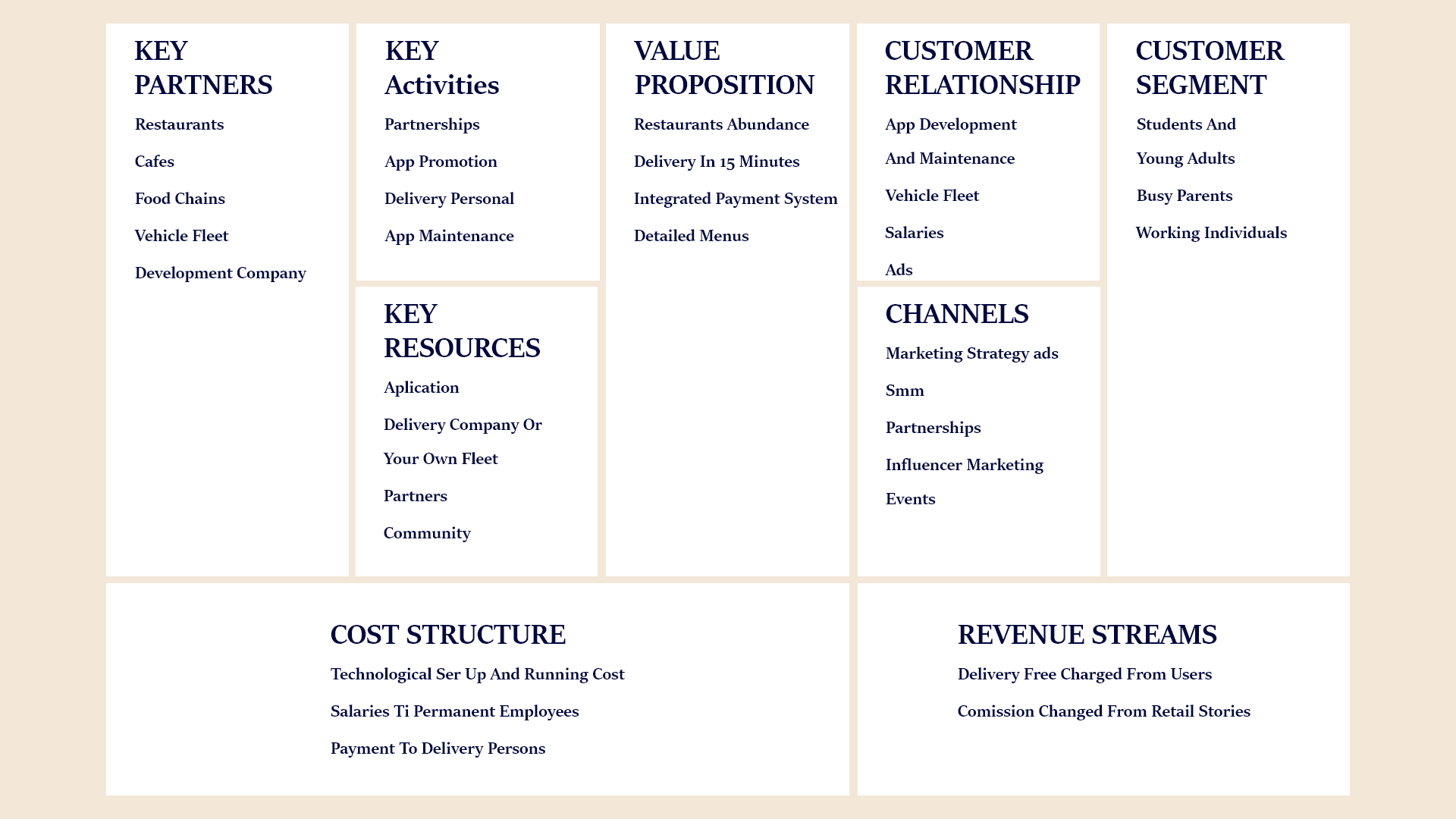
Design and Develop Your App
Two crucial stages that follow each other and constantly collaborate to polish the app by deployment. The design is based on extensive research of buyer personas, tracking the modern design trends and techniques, and developing flawless and customer-oriented UX.
The development will take more time than any stage, up to several months, depending on the app complexity, the number of platforms, and additional features.
The process of app development consists of different stages:
- UX/UI design
- Project planning
- App development
- QA and testing
- App launch
All of these services combined will help you create a robust food delivery app.
Promote Your Food Delivery Application
Marketing is the king and the component you can’t and definitely should not skip. As soon as the app design is ready, the marketing team starts implementing marketing campaigns and strategies that have been developed during the stages of market research.
A comprehensive approach will help you create a robust marketing strategy. Consider concentrating on the following types of promotion:
- Paid ads
- Social media marketing
- Influencer marketing
- Partners
How to Create Food Delivery App from the Technical Side
Food delivery app development is a process consisting of different steps. It can involve using different technologies, APIs, and third-party solutions.
Here, you can see the main technologies used for app development.
| Android | iOS | |
| Programming languages | Kotlin, Java | Swift, Objective-C |
| SDK | Android SDK | iOS SDK |
| Toolkit | Android Studio | Apple Xcode |
| Service | APIs |
| Push notifications | Twilio Nexmo Plivo Apple Push Notifications Firebase Cloud Messaging |
| Payments | PayPal Stripe Braintree Apple Pay Google Pay |
| Navigation | Google Maps Google Places Google Maps |
| Mailing services | Gmail ZeroBounce Firebase Cloud Messaging SendGrid |
| Social media | Google Facebook Twitter Instagram |
Aside from these, you might need to integrate APIs of some restaurants, delivery services, etc. The choice of technologies depends on the application type you decide to develop, the target audience, and the business model.
You might be wondering how much it will cost you to create such an app. Food delivery app development costs about $30,000 for an app with a basic set of features for a single operating system (iOS or Android). It can reach $500,000 or even more when you add additional features and platforms.
Concluding Thoughts on Food Delivery App Development
Food delivery service is one of the most promising investment segments you may think about now or soon. To kick start a successful project, we have presented the major factors and the ways to make food delivery app development more structured. All you need to do is find a reliable partner who will handle all the processes and create an app you think will work.
Food Delivery App, apps like uber eats, Create Wearable App, Healthcare in Mobile, App Cost Calculation, Wearable App Development, eLearning, Food Delivery App, Restaurant Mobile App, Learning Apps, Streaming Service Like Netflix, Food Delivery, IOT App, Cost Calculation, Wallet App, Outsource, Communication App,
Develop Your Food Delivery App
Dive into the world of food delivery with your own app
Our Expertise Covers:
✅ User-friendly ordering and payment features
✅ Real-time tracking
✅ Integration with restaurant POS systems
FAQ
Food delivery app development goes through the following steps:
- Analyze food delivery application
- Come up with a unique value proposition
- Find a reliable vendor that will help you with app creation
- Decide on the features and technologies
- Create a UX/UI design for your application
- Develop applications for customers, restaurants, and couriers
- Test your application and fix issues
- Launch your app and move on to its promotion
- Get customer feedback and plan further app growth
The creation of an application for food delivery is a complex process that comprises of different stages, namely business analysis, UX/UI design, development, QA and testing, and promotion. The first version of your application might cost you $60,000 for a single app version (for iOS or Android) and can reach $500,000 or even more depending on the number of features and platforms that you are going to target. Get in touch with us to get a professional project estimation.
The market of delivery applications for food is full of different names. Today, the list of industry leaders includes the following applications:
- DoorDash
- Uber Eats
- Seamless
- Instacart
- Grubhub
- Goldbelly
- Postmates
- Whole Foods Market
- Fresh Direct
The food delivery market is an area that is gaining traction. In 2019, the market was estimated at $107.4 billion. The market is predicted to grow at a rapid pace and reach $182.3 billion by 2024. There is still enough place for new names to enter in the following years.
There are three main types of food delivery applications that you might be interested in developing:
- aggregators with logistics
- aggregators without logistics
- hybrid food delivery solutions
All the most popular applications work by one of the models, including Doordash, Uber Eats, GrubHub, etc.
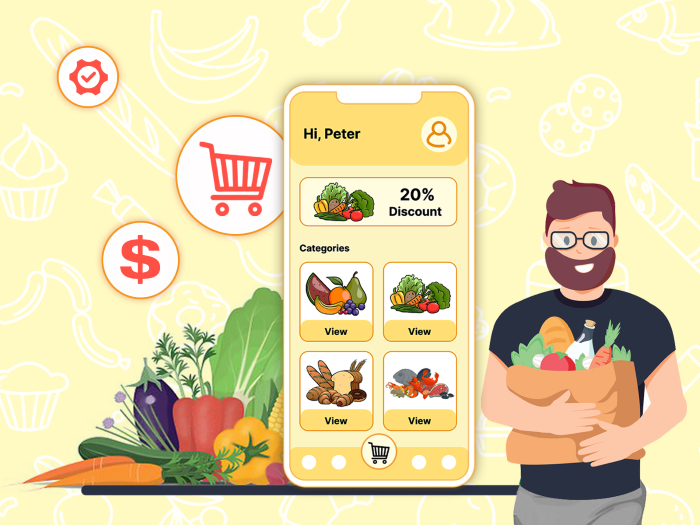 Grocery Delivery App Development: Tips, Cost & Steps
Grocery Delivery App Development: Tips, Cost & Steps
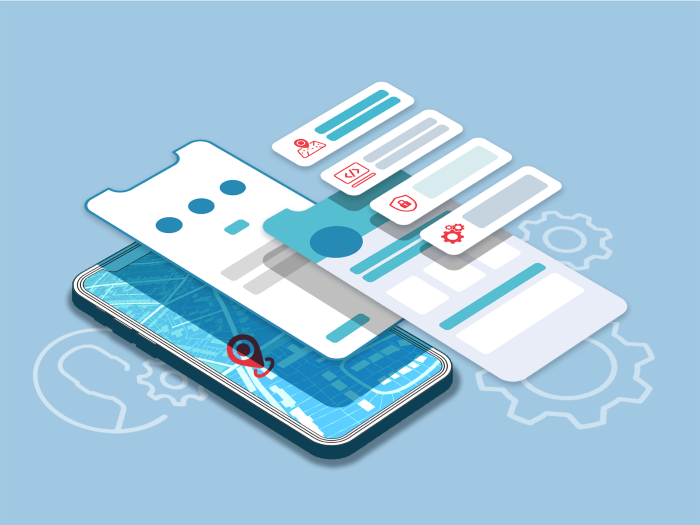 Must-Have Uber App Features: Building a Ridesharing App
Must-Have Uber App Features: Building a Ridesharing App
 How to Make an App Like Uber: Features and Tech Details
How to Make an App Like Uber: Features and Tech Details
letsdiskuss
Thank you for taking the time to write this blog post